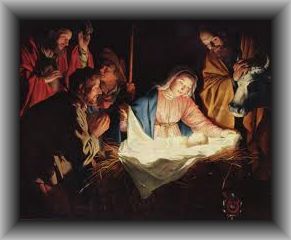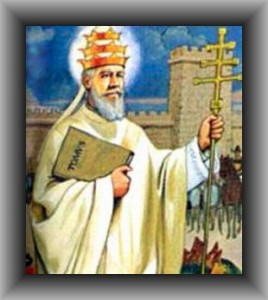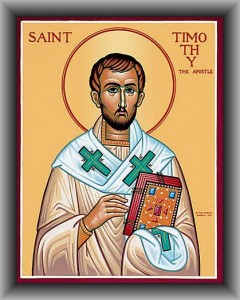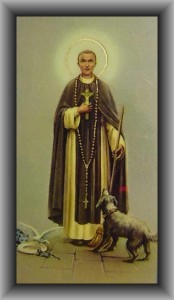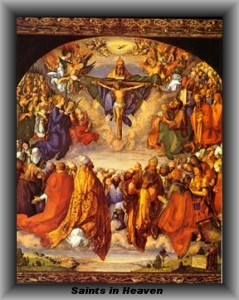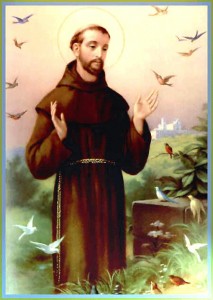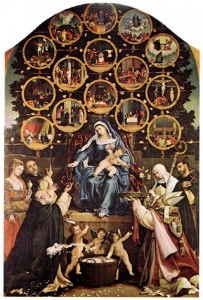Archive for the ‘Saint Articles’ Category
St. Andrew Christmas Novena to Obtain Favors
The St. Andrew Christmas Novena is named for the date on which it begins every year – the Feast of St. Andrew the apostle, November 30. It is a petition to God in honor of the birth of His Son, Jesus, Our Savior. It is piously believed that whoever faithfully recites this novena 15 times per day from November 30 until Christmas Day will obtain a request that is asked.
This novena was given the Imprimatur by Michael Augustine, Archbishop of New York, 1897
St. Andrew Christmas Novena Prayer to Obtain Favors:
Hail and blessed be the hour and moment
In which the Son of God was born
Of the most pure Virgin Mary,
At midnight, in Bethlehem,
In the piercing cold.
In that hour, vouchsafe, O my God
To hear my prayer and grant my desires,
Through the merits of Our Savior Jesus Christ,
And of His Blessed Mother.
Amen.
For Reflection: Advent is the season to prepare for the coming of Our Savior, Jesus Christ. It is very fitting that we praise and bless the moment of the birth of Jesus – the most holy of all moments in the history of mankind, with this special prayer every day of Advent until Christmas. And, as we commemorate this special moment of the birth of Jesus in prayer daily, we humbly hope that God will answer our petition. As you pray this Christmas Novena in petition and as a commemoration of the birth of Jesus how wonderful to look upon a beautiful Infant Jesus figurine.
St. Leo The Great
St. Leo the Great was Pope from 440 – 461. He was born and lived in the city of Tuscany, Italy. During this period Europe and the Catholic Church were under attack both physically and spiritually. The great Roman Empire was now being attacked and overrun by Attila the Hun. After conquering and destroying much of northern Italy, Attila marched toward Rome expecting to conquer that city as well. However, he was met by Pope St. Leo the Great who persuaded him to withdraw and leave the city of Rome unharmed. And, 2 years later Pope St. Leo was able to negotiate and prevent another attack by vandals and protect the city of Rome.
Beyond his leadership and negotiation skills, the greatest accomplishments by St. Leo the Great were the many wonderful writings he contributed as one of the early Church Fathers: 143 letters and 96 sermons. The most popular of these was the Tome which declared the doctrine of Incarnation, defining at the Council of Chalcedon, in 451, that Jesus Christ is one Divine Person with two complete natures – a human nature and a divine nature.
He was named declared a Doctor of the Church by Pope Benedict XIV. And, he actively fought against heresies which were threatening The Church of the 5th century, among them was the heresy of Pelagianism which denied original sin and Christian grace. It was through his great writings and his leadership that he was able to significantly impact the direction and acknowledgement of the role of the papacy as head of the Church.
For Reflection: St. Leo the Great exemplifies the response of a holy person to the call which God gives to each of us at Baptism – to know God, love God, and serve God. We know God as we see and hear Him in His Word (the written Word of The Gospel and The Word made flesh in Jesus, His Son). We love God in His creation – every person and creature. We serve God as we love and serve His creatures – everyone we encounter each day (our family, friends, neighbors, strangers, the poor, homeless). And, God asks us to proclaim His Word and His love to all the world.
You can express your love and devotion to your Christian faith, the saints, and St. Leo the Great as you wear a lovely St. Leo saint medal.
Bio: Marianne Buzzelli is a Catholic Secular Franciscan, writer, and entrepreneur, dedicated to the proclamation of the Gospel of Christ and to the love of Jesus, Mary, our saints, and The Church.
St. Timothy – the Disciple
Feast Day – January 26
St. Timothy was a disciple of St. Paul, the one of whom he spoke as “his beloved son”. He was a convert to Christianity born of a Jewish mother and pagan father. He was from Lystra, a city in Asia Minor where St. Paul preached the Gospel. After hearing St. Paul, Timothy was converted to Christianity along with his mother and grandmother. He was strong in his faith and even from his early childhood he spent much time in reading the Scriptures. He was very devout and fervent in his Christian faith and was eager to follow St. Paul. He devoted a great deal of his time in reading and studying Scriptures. When he grew to be a man he was recognized for his kind heart and for his knowledge and zeal for preaching the Gospel. St. Paul loved Timothy and had him accompany him on his journeys throughout Asia Minor and Greece. St. Timothy was ordained the first Bishop of Ephesus by St. Paul in the year 65 AD. He was bishop for 15 years. It was in Ephesus that Timothy received the two Epistles written by St. Paul, one which St. Paul wrote while he was in Macedonia, and the second while he was in prison in Rome. One of the most memorable legacies of the teachings of St. Timothy was in the importance of spending time reading and studying the Scriptures. He warned against gossip and profanity and exhorted Christians to be good examples in speech and action in proclaiming the Word of The Lord. St. Timothy was martyred in Ephesus for attempting to stop a pagan procession. He was stoned to death.
For Reflection: St. Timothy grew in holiness as he spent much of his time reading and studying the Gospel. And, as a result of him knowing God through His Word, he developed a great zeal to share his love of God and evangelize. We are all called to be saints. And, as St. Timothy admonishes us, we should concentrate our time on being good Christian examples of Christi in speech and action. What a wonderful way to express our Christian devotion and love for this great disciple of Christ as we wear a St. Timothy medal.
Bio: Marianne Buzzelli is a Catholic writer and owner of Holy Cross Necklaces which sells fine cross necklaces, saint medals, beautiful rosaries, and Christian rings and bracelets
St. Martin de Porres
– by Marianne Buzzelli
Feast Day Nov 3
1579 – 1639,
St. Martin de Porres was born in Lima, Peru as a son of a Spanish father and mother from Panama of Black or American Indian descent. At the age of 12 his mother sent him to be an apprentice as a barber-surgeon, which was a common tradition of barbers during that time. In their practice as barbers they also were able to care for wounds, draw blood, and give medicines as treatment for illnesses.
It was in this role that St. Martin began his care for the sick and poor. And, in addition to his love for the poor, his love for God lead him to seek entrance into the Dominican Order. In his great humility, St. Martin had thought of entering the order as a lay person to help treat the sick. He served and studied and spent much time in prayer and penance. And, with great humility, compassion, generosity, and love for the poor and sick, the religious members of his order asked to have St. Martin de Porres be professed as a Dominican brother. He cared for all people of every race, color, and social status with great love and compassion.
Among his accomplishments were assisting in founding an orphanage, raising money for poor girls as dowry for marriage or religious life, caring from slaves brought from Africa, and collected alms for the poor. He is the patron saint of the poor and social justice
Among the miracles performed by St. Martin de Porres were bilocation and curing of the sick. Much like St. Francis of Assisi who referred to himself as a poor servant, St. Martin de Porres referred to himself as a “poor slave”. Surely this wonderful saint is an example of the virtues that God asks us to develop of humility, love, and generosity with the poor. What a wonderful way to express your respect and devotion to this saint as you wear this lovely sterling silver St. Martin de Porres saint medal.
All Souls Day – History And Meaning
— by Marianne Buzzelli
On All Souls Day the Catholic Church commemorates all of the faithful departed, the souls who are in a state of purgation (purgatory) awaiting their place in heaven. We pray for the faithful departed during every Mass, as we pray for those “…who have gone before us marked with the sign of faith and… who sleep in Christ”.
What a marvelous thought of “sleeping in Christ”. For, we know that if we live in Christ we will also die in Christ. And, after death, all holy souls prior to their entrance in heaven will also be sleeping “in Christ”. As Christians we believe that as Christ died, rose, and ascended into heaven, we too, if we are in a state of grace, will have a place in heaven after our death. St. Paul speaks of this promise and hope as he writes “God will bring with Him those who have fallen asleep” (1Thes 4:13-14).
In our prayer for the dead we display our faith and hope in eternal life and participate as The Church Militant on earth as members of The Communion of Saints in requesting intercession for the faithful departed. The basis for this practice of prayer for the faithful departed is in our belief that we are all united in The Mystical Body of Christ and The Communion of Saints – The Church Militant on earth, The Church Triumphant in heaven, and The Church Suffering in Purgatory. We invoke the intercession of the glorious saints of The Church Triumphant as we do penance and pray for all those on earth, The Church Militant, and the holy souls in purgatory, The Church Suffering.
Prayer for the dead was recognized in the earliest writings of The Church. Early Church Fathers note the use of diptychs or tablets in which Christians would record the death of Christians. St. Cyprian in the third century and St. John Chrysostom in the fourth century write about these recorded deaths in diptychs. The dead were remembered with prayers and works of penance. Benedictine monks offered commemoration services for the dead during the sixth century. And, in 998 St. Odilo, the fifth Abbot of Cluny, implemented the annual commemoration of the faithful departed among all monasteries which spread among all Benedictines, and throughout the Church. Blessed John Paul II recognized the millennium commemoration of All Souls Day in his 1998 address. He cites this beautiful passage from Lumen Gentium: “Intercession for the dead, just as the life of those living according to the divine commandments, obtains the merits that serve the full attainment of salvation. It is an expression of the fraternal charity of the one family of God, by which “we are faithful to the Church’s deepest vocation” (Lumen gentium, n. 51)
It is thus, on this special feast day that we look with special love and devotion to all of the faithful departed, our family, friends, and those who have no one to pray for them. The entire month of November is dedicated to all souls in purgatory. Let us “express our fraternal charity within the one family of God” as we pray for the faithful departed and also as we invoke the intercession of Our Dear Blessed Mother as we pray on a beautiful Pearl Our Lady of Guadalupe Rosary.
Saints Simon And Jude
Feast Day : October 28
We hear in the Gospel of Luke (6:12-16) how Jesus went up to the mountain to pray and upon coming down from the mountain he chose his 12 apostles who would follow him and be his representatives and evangelists to the world. Among these were Simon, the zealot, and (Jude) Thaddeus. We celebrate the feast day of these two saints, martyrs, and apostles on October 28.
St. Jude is known in the Gospels of Matthew and Mark as Thaddeus (Mt 10:3 and Mk 3:18) and as Judas, son of James in Luke (Lk 6:16; Acts 1:13). He was the brother of James the Less. St. Simon is named in the Gospels as “Simon, the zealot”.
In his audience in St. Peter’s Square in 2006, Pope Benedict XVI speaks about the significance of these two apostles and their service to The Church. He describes the characteristic of a “zealot” as being one who is like God in his zeal and devotion for the Gospel. And, as he stated likewise St. Simon can be described as one who was likely very zealous and passionate about his love and devotion to God, God’s people, and The Church.
Additionally, we can see the great zeal of St. Jude Thaddeus in the words of his epistle. Pope Benedict points to how St. Jude warned the people to beware of those who seem to teach in God’s name but, lead men astray and can destroy The Church by causing division. But, St. Jude gives this instruction to members of The Church as he says to them : “But you, beloved” –( he is speaking to all of us ), “build yourselves up on your most holy faith; pray in the Holy Spirit; keep yourselves in the love of God; wait for the mercy of our Lord Jesus Christ unto eternal life. And convince some, who doubt…” (vv. 20-22). Indeed, we see the great zeal of St. Jude Thaddeus for preaching the Gospel to the early Church.
The Gospel of John describes this discourse between Jude Thaddeus and Jesus following the Last Supper. Thaddeus says to Jesus : “Lord, how is it that you will manifest yourself to us and not to the world?”. And, Our Lord responds in very profound words and Jesus says to him : “If a man loves me, he will keep my word, and my Father will love him, and we will come to him and make our home with him” (Jn 14: 22-23). We see in this passage addressed to St. Jude Thaddeus, Jesus telling us the importance of having God live in our hearts, but we must be open to the grace to receive Good in our hearts to abide in us. And, a prerequisite to this relationship is that we keep His Word – His commandments.
Early Church Fathers also point out that these 2 apostles, St. Jude and St. Simon, were witnesses to Jesus: on earth as members of his chosen 12 apostles, witnesses to Jesus crucified, and witnesses to Jesus risen. And, they continued to be witnesses for Jesus as they devoted their lives to go out and preach The Gospel to all of the world.
Let us follow the example of these 2 saints and apostles of Christ as we proclaim The Word of God. We can express our Christian devotion and love for Jesus, His Church, and St. Jude as we wear this St. Jude saint medal.
Prayer to The Holy Spirit
I often pray to the Holy Spirit for an increase in virutes and holiness, especially for more patience, kindness, understanding, and wisdom.
I pray this prayer to The Holy Spirit:
“Come Holy Spirit, fill the hearts of thYour faithful, and kindle in them the fire of Your love. Send forth Your Spirit and they shall be created and You shall renew the face of the earth. Amen”
You too can show your devotion and love for the Holy Spirit as you pray for the intercession of the Holy Spirit and wear this beautiful gold Holy Spirit Pendant.
St. Luke The Evangelist
Feast day – October 18
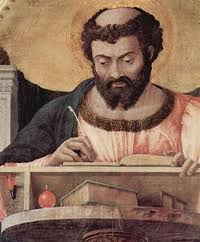 St. Luke was the author of the Gospel of St. Luke and The Acts of The Apostles. His identity as author of these books of the Bible has been confirmed by the early Church Fathers, St. Jerome, and Eusebius. He was a disciple and companion of the apostle St. Paul and accompanied him until St. Paul’s martyrdom. He has been identified inSt. Paul’s Letter to the Colossians (Col4:14) as “Luke, the beloved physician”. St. Luke was not a Jew. He was a gentile. And, therefore was able to write and communicate with the gentiles based on their tradition and customs. He lived in the Greek city of Antioch which is ancientSyria.
St. Luke was the author of the Gospel of St. Luke and The Acts of The Apostles. His identity as author of these books of the Bible has been confirmed by the early Church Fathers, St. Jerome, and Eusebius. He was a disciple and companion of the apostle St. Paul and accompanied him until St. Paul’s martyrdom. He has been identified inSt. Paul’s Letter to the Colossians (Col4:14) as “Luke, the beloved physician”. St. Luke was not a Jew. He was a gentile. And, therefore was able to write and communicate with the gentiles based on their tradition and customs. He lived in the Greek city of Antioch which is ancientSyria.
He was a very well educated man and a physician by trade. He was also a very talented artist and painter. St. Luke is said to be the first painter of Christian icons. Among the icons painted by St Luke are pictures of The Blessed Mother Mary – Our Lady of Czestochowa and Our Lady of Vladimir, St. Peter,St. Paul, and other icons of Jesus and Mary.
The Gospel of St. Luke contains many of the most well known and loved parables preached by Jesus to instruct us on our path to holiness. Among them are:
- The Parable of The Good Samaritan which describes the charity of a stranger
- The Parable of The Prodigal Son which describes the all merciful love of a father
- The Parable of The Lost Sheep explains how Jesus as the shepherd seeks the lost sinners and brings them back to his fold
- The Conversion of the repentant sinner on the cross illustrates God’s mercy and forgiveness
- The Conversion of Mary Magdalene, the repentant sinner and sister of Lazarus again illustrated God’s mercy and forgiveness
Of all of the four gospels, we find in the Gospel of Luke a focus on the infancy of Jesus. We hear a most beautiful description of the birth of Jesus in the manger at Bethlehem surrounded by Mary, Joseph, and the barn animals. And, Luke tells us of how the shepherds were called by the angels and told of the great birth of the Messiah.
The Gospel of Luke also shows us the great love of Mary, the mother of Jesus. In this Gospel we see the love St. Luke had for Mary and it is believed that he received the information about Mary found in his Gospel directly from Mary.
St. Luke is the patron saint of physicians, surgeons, artists, and painters. His writing and art have provided wonderful contributions to our knowledge of the life of Jesus, Mary, and the early Church. We can express our devotion and appreciation to this wonderful saint as we wear a beautiful St. Luke saint medal.
Saint Francis and His Life of Prayer
St. Francis exhorts his Franciscan brothers and sisters to have “prayer and contemplation be the soul of all we are and all we do”. So how do we accomplish this?
St. Thomas of Celano, St. Bonaventure, and Julian of Speyer describe Francis’ great zeal for prayer and how Francis would go off to be alone in his prayer to a cave or other solitary place in the wilderness, just as Jesus often did during his ministry. And, Francis would pray without intermission to keep himself in the continual presence of Christ, his beloved in his desire to know and live totally within the Divine Providence of God.
The Franciscan brothers asked Francis to teach them how to pray, because at that time they had not learned the prayers of the Divine Office and did not own books from which they could pray. So, Francis told them, “ When you pray say, “ Our Father…”and he taught them the Lord’s Prayer, and he told them to pray this beautiful prayer we say during benediction and Good Friday services:
“We adore you, O Christ, in all your churches throughout the world , and we bless You, for by Your holy cross You have redeemed the world.”
Thomas of Celano, the first biographer of St. Francis, said this about Francis and his life of prayer: “He does not so much pray, as he becomes himself a prayer”.
Let us ask the Holy Spirit to follow the example of St. Francis in conforming ourselves to Jesus in such a way that we too may not only have a life of deep prayer, but become a living prayer. As we remember St. Francis in our intercession we can wear a beautiful St. Francis sterling silver medal.
Our Lady of The Holy Rosary
Feast day – October 7
Our Lady of the Rosary is one of the titles given to the Blessed Mother related to her intercession accomplished through the recitation of the rosary. Many miracles have been reported to be due to Mary’s intercession at the time of danger. The early records of this miraculous intercession are noted with major wars or battles in European history following the devotion of faithful Catholics in praying the rosary to the Blessed Mother.
The first of these reported military victories was onOctober 7, 1571at the Battle of Lepanto. Christian troops defeated Turkish invaders. Prior to the battle members of the Rosary Confraternity in St. Peter’s square inRomeled a procession and prayed the rosary. Crew members on more than 200 ships and Christians throughoutEuropeprayed the rosary in response to the encouragement of the pope. In acknowledgment of Our Blessed Mother’s intercession, Pope St. Pius V ordered the faithful of the Church to commemorate the rosary on that date in October, naming the feast “Our Lady of Victory”. In 1573 Pope Gregory XII allowed the feast day to be celebrated in any church which had an altar dedicated to the Holy Rosary. He renamed the feast “Feast of the Holy Rosary”. Then, in 1671 Pope Clement X extended the feast to all of the country ofSpain. OnAugust 6, 1716, the octave of the Assumption of Mary, the feast was extended to the whole Catholic Church by Pope Clement XI, following a military victory inHungary. It was also added to the calendar of the saints during that year, celebrated on the first Sunday of October. The feast was moved to its current date of October 7 by Pope Pius X.
The rosary is an excellent form of mental and vocal prayer, which brings God’s blessings on the faithful of the Church through the intercession of Mary. It is inspired by the bible and is centered on the mysteries of Christ’s life. Mary promised great blessings to all those that pray the rosary.
As faithful Christians we often call on the intercession of our loving Blessed Mother at times of difficulties in our lives. We ask her to keep our loved ones wrapped in the mantle of her protection and guide us on our journey to heaven. Let us offer this day to Our Lady of the Holy Rosary and honor Mary as we pray to her holding a beautiful mother of pearl rosary.
